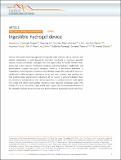| dc.contributor.author | Liu, Xinyue | |
| dc.contributor.author | Steiger, Christoph Winfried Johannes | |
| dc.contributor.author | Lin, Shaoting | |
| dc.contributor.author | Parada Hernandez, German Alberto | |
| dc.contributor.author | Liu, Ji | |
| dc.contributor.author | Chan, Hon Fai | |
| dc.contributor.author | Yuk, Hyunwoo | |
| dc.contributor.author | Phan, Nhi V | |
| dc.contributor.author | Collins, Joy E | |
| dc.contributor.author | Tamang, Siddartha M | |
| dc.contributor.author | Traverso, Carlo Giovanni | |
| dc.contributor.author | Zhao, Xuanhe | |
| dc.date.accessioned | 2022-07-08T12:57:07Z | |
| dc.date.available | 2021-10-27T20:29:46Z | |
| dc.date.available | 2022-07-08T12:57:07Z | |
| dc.date.issued | 2019 | |
| dc.identifier.uri | https://hdl.handle.net/1721.1/135879.2 | |
| dc.description.abstract | © 2019, The Author(s). Devices that interact with living organisms are typically made of metals, silicon, ceramics, and plastics. Implantation of such devices for long-term monitoring or treatment generally requires invasive procedures. Hydrogels offer new opportunities for human-machine interactions due to their superior mechanical compliance and biocompatibility. Additionally, oral administration, coupled with gastric residency, serves as a non-invasive alternative to implantation. Achieving gastric residency with hydrogels requires the hydrogels to swell very rapidly and to withstand gastric mechanical forces over time. However, high swelling ratio, high swelling speed, and long-term robustness do not coexist in existing hydrogels. Here, we introduce a hydrogel device that can be ingested as a standard-sized pill, swell rapidly into a large soft sphere, and maintain robustness under repeated mechanical loads in the stomach for up to one month. Large animal tests support the exceptional performance of the ingestible hydrogel device for long-term gastric retention and physiological monitoring. | en_US |
| dc.language.iso | en | |
| dc.publisher | Springer Science and Business Media LLC | en_US |
| dc.relation.isversionof | 10.1038/S41467-019-08355-2 | en_US |
| dc.rights | Creative Commons Attribution 4.0 International license | en_US |
| dc.rights.uri | https://creativecommons.org/licenses/by/4.0/ | en_US |
| dc.source | Nature | en_US |
| dc.title | Ingestible hydrogel device | en_US |
| dc.type | Article | en_US |
| dc.contributor.department | Massachusetts Institute of Technology. Department of Mechanical Engineering | en_US |
| dc.contributor.department | Koch Institute for Integrative Cancer Research at MIT | en_US |
| dc.contributor.department | Massachusetts Institute of Technology. Department of Chemical Engineering | en_US |
| dc.contributor.department | Massachusetts Institute of Technology. Department of Civil and Environmental Engineering | en_US |
| dc.relation.journal | Nature Communications | en_US |
| dc.eprint.version | Final published version | en_US |
| dc.type.uri | http://purl.org/eprint/type/JournalArticle | en_US |
| eprint.status | http://purl.org/eprint/status/PeerReviewed | en_US |
| dc.date.updated | 2019-07-18T14:24:17Z | |
| dspace.orderedauthors | Liu, X; Steiger, C; Lin, S; Parada, GA; Liu, J; Chan, HF; Yuk, H; Phan, NV; Collins, J; Tamang, S; Traverso, G; Zhao, X | en_US |
| dspace.date.submission | 2019-07-18T14:24:18Z | |
| mit.journal.volume | 10 | en_US |
| mit.journal.issue | 1 | en_US |
| mit.metadata.status | Publication Information Needed | en_US |
